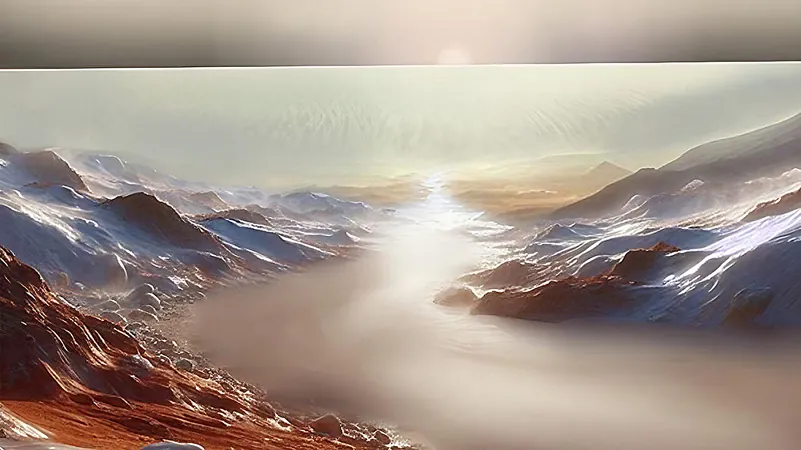
Shocking Discovery: Rivers Weren't Just a Dream on Ancient Mars!
2024-11-04
Author: Liam
Recent groundbreaking research published in the Journal of Geophysical Research: Planets has revealed astonishing details about the Martian landscape 3.6 billion years ago, confirming that rivers flowed and massive lakes, comparable in size to the Mediterranean Sea, existed under thick ice coverings.
Research Leadership and Findings
Led by Planetary Science Institute's Peter Buhler, the study reveals that during this ancient period, Mars underwent a significant carbon dioxide collapse. Atmospheric carbon dioxide froze out, creating a massive layer on top of a water ice sheet at the poles. This process insulated heat from the planet's interior, increasing pressure on the ice and ultimately melting a substantial portion of Mars' water reserves—enough to initiate vast rivers across its surface without the need for climate warming.
Innovative Modeling of Mars' Carbon Cycle
Buhler's innovative work extends from his prior studies of the contemporary carbon dioxide cycle on Mars, where he has created a model that investigates how this gas interacts with Martian regolith, which consists of sand and rocks. His research offers a comprehensive view of the carbon cycle from the regolith, to the atmosphere, and finally, to the frozen polar ice caps.
Contributions to Understanding Mars' Geography
With this model, we can explain the formation of Mars' most significant geographical features—its largest lakes and valley systems—through a self-consistent process that mirrors what we're currently observing on the planet,” Buhler stated. This revolutionary approach strongly indicates that the atmospheric changes of that era were crucial in shaping the Martian surface we study today.
Role of Regolith and Axial Tilt
Notably, since the 1970s, scientists have recognized that a significant amount of Mars' carbon dioxide is trapped within the regolith. Buhler's model highlighted that while the atmosphere is important, the real action happens at the interface between the regolith and the ice caps. The planet’s axial tilt, oscillating over 100,000-year cycles, further influences this exchange, determining whether carbon dioxide sublimates into the atmosphere or deposits on the polar ice.
Subglacial Rivers and Eskers
Buhler’s simulations revealed that thick layers of carbon dioxide acted as a powerful insulator, trapping heat from Mars' interior. This pressure-induced melting produced vast amounts of water, leading to the development of rivers that shaped the Martian landscape. Remarkably, these subglacial rivers created long ridges known as eskers, which scientists have found near the south pole. Buhler's model aligns with his findings, providing a compelling explanation for their existence without relying on unexplained global warming events.
Ancient Water Flow and Implications
As these subglacial rivers flowed, they eventually reached the surface, creating slow-moving, ice-covered waterways that expanded across the landscape. Buhler predicts that these rivers were significant, potentially reaching thousands of miles in length and culminating in the filling of the Argyre Basin, a colossal site where meltwater accumulated over vast periods.
Challenges to Established Theories
This revolutionary model doesn't just rewrite the story of ancient Martian water; it challenges long-standing theories that tied such activity to warming events. Instead, it presents a pole-to-equator hydrologic cycle powered by natural processes linked to the planet's carbon dynamics.
Future Research Directions
As Buhler moves forward with his research, further testing of this model could fundamentally alter our understanding of Mars' hydrological history. This incredible journey into Mars' past opens up new avenues of exploration that may bring to light the mysteries of water flow and its implications for past life on the red planet.
Stay tuned as we unravel more secrets of Mars and the potential for life in its ancient, water-rich environments!









 Brasil (PT)
Brasil (PT)
 Canada (EN)
Canada (EN)
 Chile (ES)
Chile (ES)
 España (ES)
España (ES)
 France (FR)
France (FR)
 Hong Kong (EN)
Hong Kong (EN)
 Italia (IT)
Italia (IT)
 日本 (JA)
日本 (JA)
 Magyarország (HU)
Magyarország (HU)
 Norge (NO)
Norge (NO)
 Polska (PL)
Polska (PL)
 Schweiz (DE)
Schweiz (DE)
 Singapore (EN)
Singapore (EN)
 Sverige (SV)
Sverige (SV)
 Suomi (FI)
Suomi (FI)
 Türkiye (TR)
Türkiye (TR)